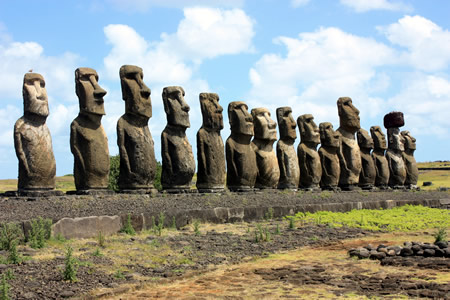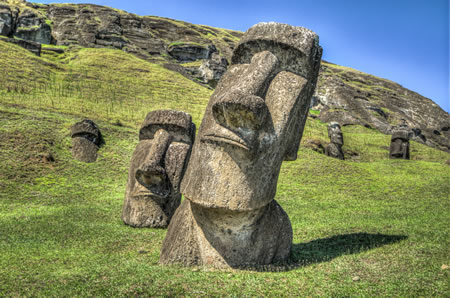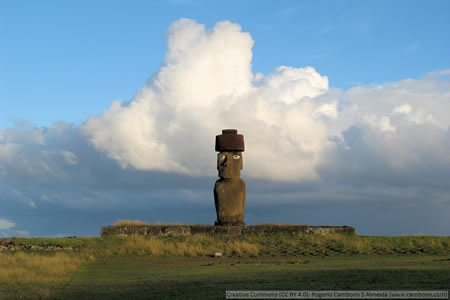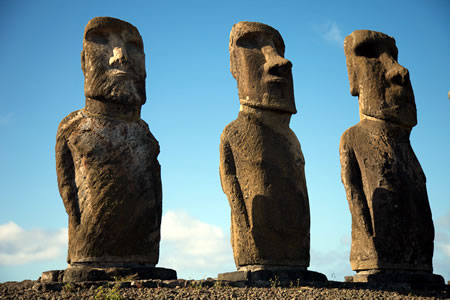Moai
Easter Island (Rapa Nui: Rapa Nui, Spanish: Isla de Pascua) is a Chilean island in the southeastern Pacific Ocean, at the southeasternmost point of the Polynesian Triangle in Oceania. Easter Island is famous for its 887 extant monumental statues, called moai, created by the early Rapa Nui people. In 1995, UNESCO named Easter Island a World Heritage Site, with much of the island protected within Rapa Nui National Park.
Polynesian people most likely settled on Easter Island sometime between 700 and 1100 CE, and created a thriving and industrious culture as evidenced by the island's numerous enormous stone moai and other artefacts. However, human activity, the introduction of the Polynesian rat and overpopulation led to gradual deforestation and extinction of natural resources which severely weakened the Rapa Nui civilization. By the time of European arrival in 1722, the island's population had dropped to 2,000–3,000 from an estimated high of approximately 15,000 just a century earlier. European diseases and Peruvian slave raiding in the 1860s further reduced the Rapa Nui population, to a low of only 111 inhabitants in 1877.
 Easter Island is one of the most remote inhabited islands in the world. The nearest inhabited land (around 50 residents in 2013) is Pitcairn Island, 2,075 kilometres (1,289 mi) away; the nearest town with a population over 500 is Rikitea, on the island of Mangareva, 2,606 km (1,619 mi) away; the nearest continental point lies in central Chile, 3,512 kilometres (2,182 mi) away.
Easter Island is one of the most remote inhabited islands in the world. The nearest inhabited land (around 50 residents in 2013) is Pitcairn Island, 2,075 kilometres (1,289 mi) away; the nearest town with a population over 500 is Rikitea, on the island of Mangareva, 2,606 km (1,619 mi) away; the nearest continental point lies in central Chile, 3,512 kilometres (2,182 mi) away.
Easter Island is a special territory of Chile that was annexed in 1888. Administratively, it belongs to the Valparaíso Region, and, more specifically, it is the only commune of the Province Isla de Pascua. According to the 2012 Chilean census, the island has about 5,800 residents, of whom some 60 percent are descendants of the aboriginal Rapa Nui.
Easter Island is considered part of Insular Chile.
History
Estimated dates of initial settlement of Easter Island have ranged from 300 to 1200 AD, approximately coinciding with the arrival of the first settlers in Hawaii. Rectifications in radiocarbon dating have changed almost all of the previously posited early settlement dates in Polynesia. Rapa Nui is now considered to have been settled in the narrower range of 700 to 1100 AD. Ongoing archaeological studies suggest a still-later date: "Radiocarbon dates for the earliest stratigraphic layers at Anakena, Easter Island, and analysis of previous radiocarbon dates imply that the island was colonized late, about 1200 AD. Significant ecological impacts and major cultural investments in monumental architecture and statuary thus began soon after initial settlement."
According to oral tradition, the first settlement was at Anakena. Researchers have noted that the Caleta Anakena landing point provides the island's best shelter from prevailing swells as well as a sandy beach for canoe landings and launchings so it appeals as a likely early place of settlement. However, this conclusion contradicts radiocarbon dating, according to which other sites preceded Anakena by many years, especially the Tahai, whose radiocarbon dates precede Anakena's by several centuries.
 The island was most likely populated by Polynesians who navigated in canoes or catamarans from the Gambier Islands (Mangareva, 2,600 km (1,600 mi) away) or the Marquesas Islands, 3,200 km (2,000 mi) away. According to some theories, such as the Polynesian Diaspora Theory, there is a possibility that early Polynesian settlers arrived from South America due to their remarkable sea-navigation abilities. Theorists have supported this through the agricultural evidence of the sweet potato. The sweet potato was a favoured crop found among Polynesian society for generations. However, the origins of the sweet potato trace back to South America, proving evidence of interaction at some point in time between these two geographic areas. When James Cook visited the island, one of his crew members, a Polynesian from Bora Bora, Hitihiti, was able to communicate with the Rapa Nui. The language most similar to Rapa Nui is Mangarevan, with an estimated 80 percent similarity in vocabulary. In 1999, a voyage with reconstructed Polynesian boats was able to reach Easter Island from Mangareva in 19 days.
The island was most likely populated by Polynesians who navigated in canoes or catamarans from the Gambier Islands (Mangareva, 2,600 km (1,600 mi) away) or the Marquesas Islands, 3,200 km (2,000 mi) away. According to some theories, such as the Polynesian Diaspora Theory, there is a possibility that early Polynesian settlers arrived from South America due to their remarkable sea-navigation abilities. Theorists have supported this through the agricultural evidence of the sweet potato. The sweet potato was a favoured crop found among Polynesian society for generations. However, the origins of the sweet potato trace back to South America, proving evidence of interaction at some point in time between these two geographic areas. When James Cook visited the island, one of his crew members, a Polynesian from Bora Bora, Hitihiti, was able to communicate with the Rapa Nui. The language most similar to Rapa Nui is Mangarevan, with an estimated 80 percent similarity in vocabulary. In 1999, a voyage with reconstructed Polynesian boats was able to reach Easter Island from Mangareva in 19 days.
According to oral traditions recorded by missionaries in the 1860s, the island originally had a strong class system, with an ariki, or high chief, wielding great power over nine other clans and their respective chiefs. The high chief was the eldest descendent through first-born lines of the island's legendary founder, Hotu Matu'a. The most visible element in the culture was the production of massive statues called moai that some believe represented deified ancestors. According to National Geographic, "Most scholars suspect that the moai were created to honor ancestors, chiefs, or other important personages, However, no written and little oral history exists on the island, so it’s impossible to be certain."
It was believed that the living had a symbiotic relationship with the dead in which the dead provided everything that the living needed (health, fertility of land and animals, fortune etc.) and the living, through offerings, provided the dead with a better place in the spirit world. Most settlements were located on the coast and most moai were erected along the coastline, watching over their descendants in the settlements before them, with their backs toward the spirit world in the sea.
Jared Diamond suggested that cannibalism took place on Easter Island after the construction of the moai contributed to environmental degradation when extreme deforestation destabilized an already precarious ecosystem. Archeological record shows that at the time of the initial settlement the island was home to many species of trees, including at least three species which grew up to 15 metres (49 ft) or more: Paschalococos – possibly the largest palm trees in the world at the time, Alphitonia zizyphoides, and Elaeocarpus rarotongensis, as well as at least six species of native land birds. A major factor that contributed to the extinction of multiple plant species was the introduction of the Polynesian rat. Studies by paleobotanists have shown rats can dramatically affect the reproduction of vegetation in an ecosystem. In the case of Rapa Nui, recovered plant shell seeds showed markings of being gnawed on by rats. Barbara A. West wrote, "Sometime before the arrival of Europeans on Easter Island, the Rapanui experienced a tremendous upheaval in their social system brought about by a change in their island's ecology... By the time of European arrival in 1722, the island's population had dropped to 2,000–3,000 from a high of approximately 15,000 just a century earlier."
 By that time, 21 species of trees and all species of land birds became extinct through some combination of overharvesting/overhunting, rat predation, and climate change. The island was largely deforested, and it did not have any trees more than 3 metres (10 feet) tall. Loss of large trees meant that residents were no longer able to build seaworthy vessels, significantly diminishing their fishing abilities. One theory regarding the deforestation that caused such ecological and social damage was that the trees were used as rollers to move the statues to their place of erection from the quarry at Rano Raraku. Deforestation also affected agricultural production on Rapa Nui. At first, the native tropical forests provided ideal shade cover for soil. But with many of the native forest being destroyed, the topsoil became eroded causing a sharp decline in agricultural production. This was further exacerbated by the loss of land birds and the collapse in seabird populations as a potential source of food. By the 18th century, residents of the island were largely sustained by farming, with domestic chickens as the primary source of protein.
By that time, 21 species of trees and all species of land birds became extinct through some combination of overharvesting/overhunting, rat predation, and climate change. The island was largely deforested, and it did not have any trees more than 3 metres (10 feet) tall. Loss of large trees meant that residents were no longer able to build seaworthy vessels, significantly diminishing their fishing abilities. One theory regarding the deforestation that caused such ecological and social damage was that the trees were used as rollers to move the statues to their place of erection from the quarry at Rano Raraku. Deforestation also affected agricultural production on Rapa Nui. At first, the native tropical forests provided ideal shade cover for soil. But with many of the native forest being destroyed, the topsoil became eroded causing a sharp decline in agricultural production. This was further exacerbated by the loss of land birds and the collapse in seabird populations as a potential source of food. By the 18th century, residents of the island were largely sustained by farming, with domestic chickens as the primary source of protein.
As the island became overpopulated and resources diminished, warriors known as matatoa gained more power and the Ancestor Cult ended, making way for the Bird Man Cult. Beverly Haun wrote, "The concept of mana (power) invested in hereditary leaders was recast into the person of the birdman, apparently beginning circa 1540, and coinciding with the final vestiges of the moai period." This cult maintained that, although the ancestors still provided for their descendants, the medium through which the living could contact the dead was no longer statues, but human beings chosen through a competition. The god responsible for creating humans, Makemake, played an important role in this process. Katherine Routledge, who systematically collected the island's traditions in her 1919 expedition, showed that the competitions for Bird Man (Rapanui: tangata manu) started around 1760, after the arrival of the first Europeans, and ended in 1878, with the construction of the first church by Roman Catholic missionaries who formally arrived in 1864. Petroglyphs representing Bird Men on Easter Island are exactly the same as some in Hawaii, indicating that this concept was probably brought by the original settlers; only the competition itself was unique to Easter Island.
According to Diamond and Heyerdahl's version of the island's history, the huri mo'ai—"statue-toppling"—continued into the 1830s as a part of fierce internal wars. By 1838 the only standing moai were on the slopes of Rano Raraku, in Hoa Hakananai'a in Orongo, and Ariki Paro in Ahu Te Pito Kura. A study headed by Douglas Owsley published in 1994 asserted that there is little archaeological evidence of pre-European societal collapse. Bone pathology and osteometric data from islanders of that period clearly suggest few fatalities can be attributed directly to violence.
The first-recorded European contact with the island was on 5 April (Easter Sunday), 1722, when Dutch navigator Jacob Roggeveen visited the island for a week and estimated a population of 2,000 to 3,000 inhabitants. The number may have been greater, since some may have been frightened into hiding by a misunderstanding that led Roggeveen's men to fire on the natives, killing more than a dozen and wounding several more.
The next foreign visitors (on 15 November 1770) were two Spanish ships, San Lorenzo and Santa Rosalia, under the command of Captain Don Felipe Gonzalez. The Spanish reported the island as largely uncultivated, whose seashore was lined with stone statues.
Four years later, in 1774, British explorer James Cook visited Easter Island; he reported that some statues had been toppled. Through the interpretation of Hitihiti, Cook learned the statues commemorated their former high chiefs, including their names and ranks. The British ship HMS Blossom arrived in 1825 and reported seeing no standing statues. Easter Island was approached many times during the 19th century, but by then the islanders had become openly hostile to any attempt to land, and very little new information was reported before the 1860s.
Culture
The large stone statues, or moai, for which Easter Island is famous, were carved in the period 1100–1680 CE (rectified radio-carbon dates). A total of 887 monolithic stone statues have been inventoried on the island and in museum collections. Although often identified as "Easter Island heads", the statues have torsos, most of them ending at the top of the thighs, although a small number are complete figures that kneel on bent knees with their hands over their stomachs. Some upright moai have become buried up to their necks by shifting soils.
 Almost all (95%) moai were carved from compressed, easily worked solidified volcanic ash or tuff found at a single site on the side of the extinct volcano Rano Raraku. The native islanders who carved them used only stone hand chisels, mainly basalt toki, which lie in place all over the quarry. The stone chisels were sharpened by chipping off a new edge when dulled. While sculpting was going on, the volcanic stone was splashed with water to soften it. While many teams worked on different statues at the same time, a single moai took a team of five or six men approximately a year to complete. Each statue represented the deceased head of a lineage.
Almost all (95%) moai were carved from compressed, easily worked solidified volcanic ash or tuff found at a single site on the side of the extinct volcano Rano Raraku. The native islanders who carved them used only stone hand chisels, mainly basalt toki, which lie in place all over the quarry. The stone chisels were sharpened by chipping off a new edge when dulled. While sculpting was going on, the volcanic stone was splashed with water to soften it. While many teams worked on different statues at the same time, a single moai took a team of five or six men approximately a year to complete. Each statue represented the deceased head of a lineage.
Only a quarter of the statues were installed. Nearly half remained in the quarry at Rano Raraku, and the rest sat elsewhere, presumably on their way to intended locations. The largest moai raised on a platform is known as "Paro". It weighs 82 tonnes (90.4 short tons), and is 9.89 m (32.4 ft) long. Several other statues of similar weight were transported to ahu on the north and south coasts.
Possible means by which the statues were moved include employment of a miro manga erua, a Y-shaped sledge with cross pieces, pulled with ropes made from the tough bark of the hau tree and tied around the statue's neck. Anywhere from 180 to 250 men were required for pulling, depending on the size of the moai. Some 50 of the statues were re-erected in modern times. One of the first was on Ahu Ature Huke in Anakena beach in 1956. It was raised using traditional methods during a Heyerdahl expedition.
Another method that might have been used would be to attach ropes to the statue and rock it, tugging it forward as it rocked. This would fit the legend of the Mo'ai 'walking' to their final locations. This might have been managed by as few as 15 people, supported by the following evidence:
- The heads of the moai in the quarry are sloped forward whereas the ones moved to final locations are not. This would serve to provide a better centre of gravity for transport.
- The statues found along the transport roads have wider bases than statues installed on ahu; this would facilitate more stable transport. Studies have shown fractures along the bases of the statues in transport; these could have arisen from rocking the statue back and forth and placing great pressures on the edges. The statues found mounted on ahu do not have wide bases and stone chips found at the sites suggest they were further modified on placement.
- The abandoned and fallen statues near the old roads are found (more often than would be expected from chance) face down on ascending grades and on their backs when headed uphill. Some were documented standing upright along the old roads, e.g., by a party from Captain Cook's voyage that rested in the shade of a standing statue. This would be consistent with upright transport.
There is debate around the moai regarding the effects of the monument creation process on the environment. Some believe that the process of creating the moai caused widespread deforestation and ultimately a civil war over scarce resources.
In 2011, a large moai statue was excavated from the ground. During the same excavation program, some larger moai were found to have complex dorsal petroglyphs, revealed by deep excavation of the torso.
Gallery
Megalithic Builders is an index of ancient sites from around the world that contain stone megaliths or interlocking stones. Genus Dental Sacramento

